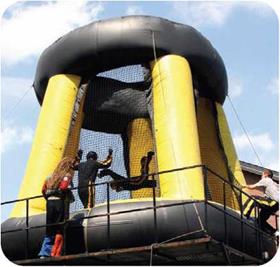Air Pressure and Temperature
Early wind tunnel tests sometimes produced results that did not agree with measurements taken from real aircraft in flight tests. Researchers found that more accurate results were often obtained by increasing the air pressure inside the wind tunnel. If a model one-fifth the size of a real aircraft was tested, the results would be more accurate if the air pressure was increased fivefold. The first high-pressure wind tunnel was used at the Langley Research Center (now part of NASA) in 1923.
There also are refrigerated wind tunnels. The air is chilled to sub-zero temperatures to study the problem of icing, when ice builds up on an aircraft’s wings and air inlets.
The world’s biggest wind tunnel is at NASA’s Ames Research Center. Its test section is big enough for aircraft with a wingspan of 100 feet (30 meters). Air is blown through the tunnel by six fans, each as tall as a four-story building.
VERTICAL WIND TUNNELS
Vertical wind tunnels blow air straight upward. These wind tunnels are not used for aerodynamic testing. They are used by people who want to practice or just enjoy the sensation of skydiving without having to jump out of an aircraft. The skydiver is held aloft by the air blasting upward. Some vertical wind tunnels are completely enclosed and recirculate the same air. Others are outside, and the sky – diver floats in open air. The airspeed is usually adjustable, up to about 140 miles per hour (225 kilometers per hour), to match the ability of the skydiver.
|
4___________________________ У |
N
SEE ALSO:
• Aerodynamics • Aircraft Design
• Pressure • Speed • Wright, Orville and Wilbur
_____________________________________________ /











